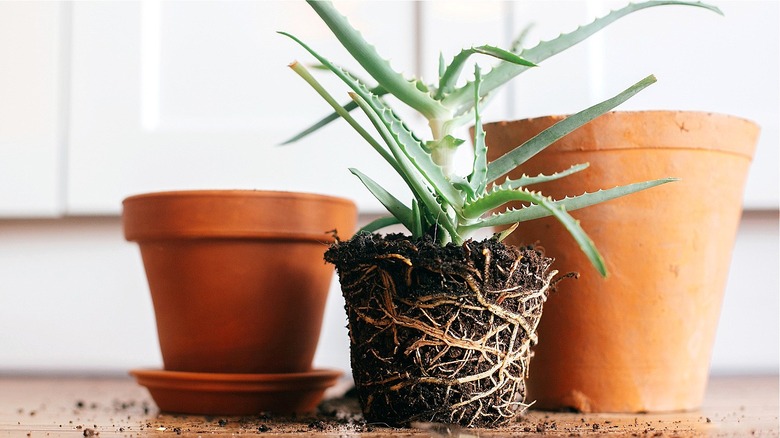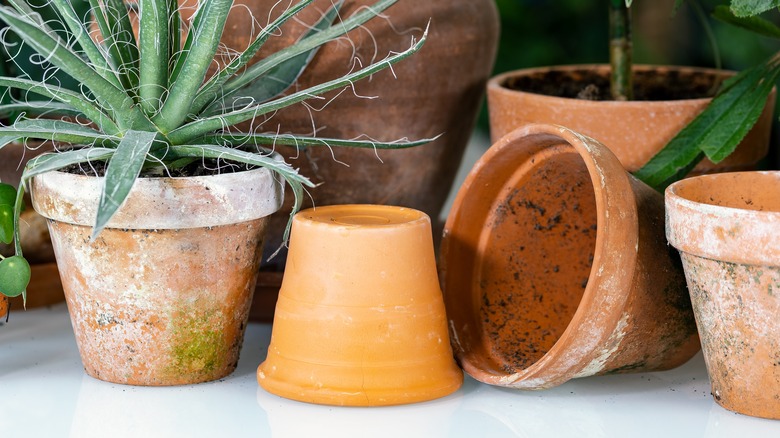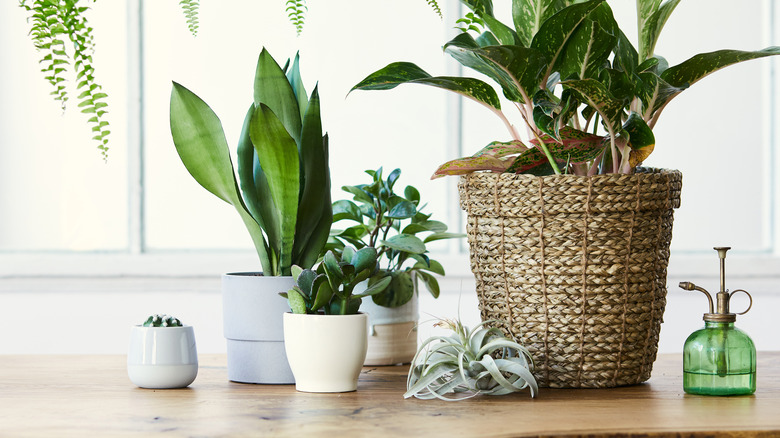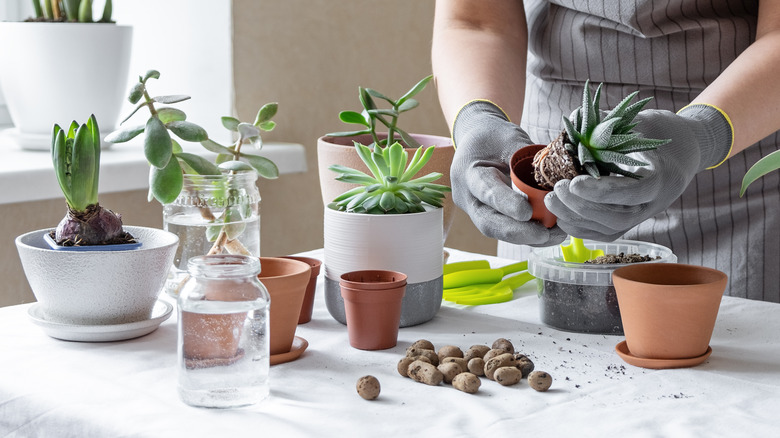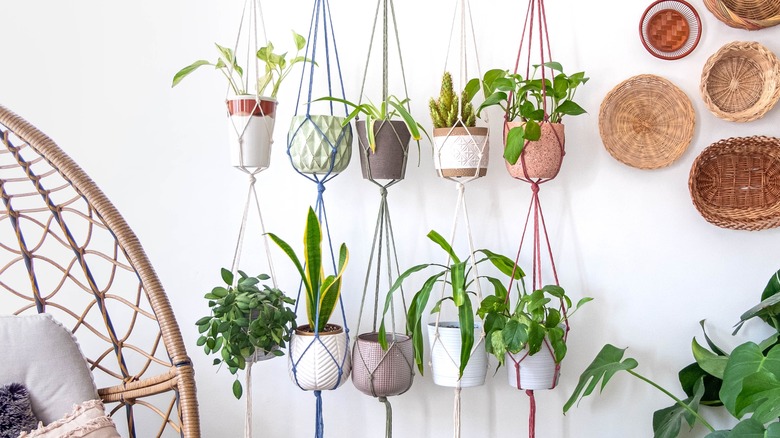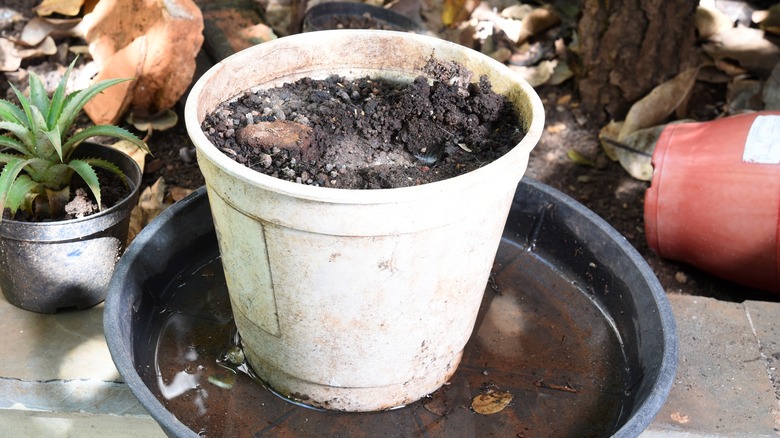The Best Tips For Choosing The Right Container For Your Indoor Plants
Repotting a plant can feel like a big task. Not only are you worried about transferring the plant from the old pot to a new one without damaging it or killing it, but it can also be challenging to know how to choose the perfect pot. Greenery Unlimited says a plant pot is your plant's home and is a massive factor in your plant's health. It's also a choice that affects the aesthetic of your décor.
There are many reasons to decide it's time to repot, but the most common is that a plant has outgrown its current pot. Another common time is when you get a new plant. There's a bit of controversy over whether or not you should repot a plant you've just bought from the store. And the controversy likely stems (pun intended) from the fact that it depends on the plant. For example, is the plant root-bound? Does the plant have pests? Is it a plant that will react poorly to its roots being messed with, like a hoya or wax plant (via Properly Rooted)? The best way to understand if you should repot the plant right away is to inspect the plant and do some research on that variety of plant to see what it prefers.
So whether it's a new plant you just bought or an old favorite that's outgrown its space, here's what you need to know when picking a new container for your indoor plants.
Drainage is everything
According to The Washington Post, overwatering is the most common way houseplant parents kill their plants. It's easy to be too loving with your plants and provide them with a deadly amount of water. However, even if you're not a chronic overwaterer, finding a pot with good drainage is vital to the long-term health of your plant.
This doesn't mean you can't successfully grow a plant in a pot without a drainage hole, but it sure makes it easier. You can more easily take the pot to the sink or shower for a good soak, then let the water drip out the bottom before returning it to its place. This will reduce the risk of water sitting in the bottom of the pot and causing root rot. Unfortunately, an excess amount of moisture also introduces the risk of pests and disease, which can weaken or even kill your plant.
However, if you've fallen in love with a pot that doesn't have a drainage hole, it doesn't mean you can't have it. You can either create a hole with a drill or invest in a moisture meter to accurately measure whether the plant needs to be watered.
Consider the height and width
The size of the plant's leaves doesn't determine how big the pot should be. Martha Stewart talks about the importance of what's going on in the soil when deciding on a container for your plant. The best way to understand your plant's roots' needs is to research that specific plant and check out the roots yourself. Then, gently pull out the plant and see if the roots are swirling around the pot or if they have enough space. You can then decide if you need a bigger pot or a similar size. Sometimes a plant needs new soil but doesn't need a bigger pot.
Using a pot that's too big for the plant can increase the risk of root rot, says Martha Stewart. This is because with too much soil and not enough roots to soak up the water; it's more likely that water will sit in the pot. But using a pot that's too small will restrict your plant, and while some plants don't mind being root-bound for a while, it's best to give them plenty of space. That way, the soil has enough nutrients and areas for moisture to hold onto while the plant soaks it up.
How material makes a difference
The material the pot is made of can make a huge difference in how healthy the plant is and how it looks within your home. Additionally, weight and durability are factors to consider when choosing the type of material for your pot. Terracotta is a classic choice and is ideal for plants that don't want to sit in water. They're also affordable and come in a wide range of sizes and shapes (via MasterClass).
Terracotta can break if dropped, however, and develop a salt crust on the exterior after continuous watering. The salt can easily be washed off, but it's something to remember when considering the aesthetics. Plastic containers are lightweight and affordable. You can easily find them in any size, color, or pattern. However, they aren't very durable and might break if you drop them.
Glazed ceramic pots are very aesthetically pleasing and can be found in various colors, shapes, sizes, and patterns. According to Instructables Living, they do hold onto moisture and will break if dropped. If you bring your plants into the shower for watering, you could chip them if you set them down too rough or if it bumps into another pot. Ceramic is also pretty heavy and could make it harder to carry the pots to the sink or shower.
Aesthetic matters too
Plants are living things that should be cared for properly, but they're also fantastic decorations within your home. With a nice pot, you will likely enjoy the plant and its beautiful foliage even more. My Tasteful Space talks about matching the color of the container with the plant with contrasting colors. Additionally, finding a pot that'll look proportionally correct with the size of the plant is vital to ensuring it doesn't look top- or bottom-heavy. This can appear awkward and won't suit the plant or your home.
Finding the perfect balance of function and beauty has been made much easier with garden centers and online stores stocking a wide range of pots. You can easily find a terracotta pot of any size or a unique color in ceramic or plastic. With some pre-planning and smart shopping, you'll find a pot that suits your design and houseplant. And if you find a container that's perfect in every way but doesn't have a drainage hole, Bio Advanced suggests using a double potting technique. Double potting is when you keep the plant in a nursery pot or terracotta pot which has a drainage hole and slip it into the pretty pot you want to use as a display. This gives you the best of both worlds!
Clean it before using it
If you're like many plant parents, you probably have a stash of empty and used pots in your garage or shed. Whether from plants that grew out of them or, sadly, from plants that died, it's common for plant owners to reuse older pots that they've used in the past. While this is a fantastic way to save money and recycle, it's vital to your plant's health to properly clean and disinfect the container before you put the new plant into it (via Old Farmer's Almanac). Pests and diseases can easily be transmitted through older pots, and you won't want that brand-new plant to die before it even gets a chance to thrive.
The Old Farmer's Almanac says to clean the pots first and scrape off any lingering soil or roots that might have been left behind. Then you can either use 1 part water and 1 part bleach or substitute the bleach for vinegar. Soak the pot in this mixture for an hour (if using vinegar, soak for a few hours). Then use a bristle brush and clean the pot with soap and water. Now all the potential eggs of pests or diseases have been killed, and it's safe to use.
